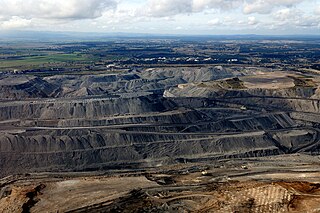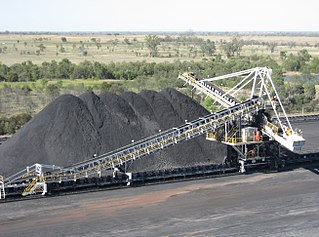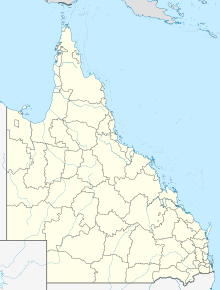
Coalbed methane, coalbed gas, coal seam gas (CSG), or coal-mine methane (CMM) is a form of natural gas extracted from coal beds. In recent decades it has become an important source of energy in United States, Canada, Australia, and other countries.

Rio Tinto Group is an Anglo-Australian multinational company that is the world's second-largest metals and mining corporation. The company was founded in 1873 when of a group of investors purchased a mine complex on the Rio Tinto, in Huelva, Spain, from the Spanish government. Since then the company has grown through a long series of mergers and acquisitions, and has placed itself among the world leaders in the production of many commodities, including aluminum, iron ore, copper, uranium and diamonds. Although primarily focused on extraction of minerals, Rio Tinto also has significant operations in refining, particularly the refining of bauxite and iron ore. Rio Tinto has joint head offices in London and Melbourne.
The Surat Basin is a geological basin in eastern Australia. It is part of the Great Artesian Basin drainage basin of Australia. The Surat Basin extends across an area of 270,000 square kilometres and the southern third of the basin occupies a large part of northern New South Wales, the remainder is in Queensland. It comprises Jurassic through to Cretaceous aged sediments derived from Triassic and Permian arc rocks of the Hunter-Bowen orogeny. Towns situated above the basin, once dominated by agriculture, are experiencing a boom as mines and infrastructure in the area are expanded.
Aurizon is a freight rail transport company in Australia, formerly named QR National. As of 2015 it was the world’s largest rail transporter of coal from mine to port. Formerly a Queensland Government-owned company, it was privatised and floated on the ASX in November 2010. The company was originally established in 2004–05 when the coal, bulk, and container transport divisions from Queensland Rail were brought under one banner, as QR National. The new name, Aurizon, comes from the words Australia and Horizon according to the then-CEO Lance Hockridge.
Rio Tinto Coal Australia (RTCA) was an Australian coal mining organisation, that was part of the worldwide Rio Tinto Group. In 2018, Rio Tinto completed the sale of its remaining assets

The Bowen Basin contains the largest coal reserves in Australia. This major coal-producing region contains one of the world's largest deposits of bituminous coal. The Basin contains much of the known Permian coal resources in Queensland including virtually all of the known mineable prime coking coal. It was named for the Bowen River, itself named after Queensland's first Governor, Sir George Bowen.

Coal is mined in every state of Australia. The largest black coal resources occur mainly in Queensland and New South Wales. About 70% of coal mined in Australia is exported, mostly to eastern Asia, and of the balance most is used in electricity generation. In 2019-20 Australia exported 390 Mt of coal as was the world's largest exporter of metallurgical coal and second largest exporter of thermal coal.
÷Some of the more notable coal companies in Australia are the following:
The Yarrabee Coal Mine is a coal mine located in the Bowen Basin in Jellinbah in Central Queensland, Australia. The mine has coal reserves amounting to 180.6 million tonnes of Thermal and Coking coal, one of the largest coal reserves in Asia and the world. The mine has an annual production capacity of 3.2 million tonnes of coal. The coal is primarily sold for use as PCI coal in steel making.

The Blair Athol Coal Mine is a coal mine located in the Bowen Basin of Central Queensland, Australia. It is located over the former site of the township of Blair Athol. The mine has coal reserves amounting to 195 million tonnes of Thermal coal, one of the largest coal reserves in Asia and the world. The mine has an annual production capacity of 12.9 million tonnes of coal.
The Collinsville Coal Mine is a coal mine located near Collinsville in Central Queensland, Australia. The open-cut mine lies in the northern Bowen Basin. Collinsville produces coking and steaming coal for both domestic use and export. Exports leave the country via Abbot Point.
The Coppabella Coal Mine is an open-cut coal mine located in Strathfield, Isaac Region, Central Queensland, Australia. It lies in the eastern part of the Bowen Basin near the towns of Nebo and Moranbah. The coal is dated to the Late Permian age]] and are located within the Rangal Coal Measures.
The German Creek Coal Mine is an underground coal mine 25 kilometres south west of Middlemount in Central Queensland, Australia. The mine has coal reserves amounting to 248 million tonnes of coking coal, one of the largest coal reserves in Asia and the world. The mine has an annual production capacity of 6 million tonnes of coal.
The Gregory Coal Mine is an open-cut coal mine located at Crinum, 60 km north east of Emerald in Central Queensland, Australia. The mine has coal reserves amounting to 159 million tonnes of coking coal, one of the largest coal reserves in Australia and the world. The Bowen Basin mine has an annual production capacity of 5 million tonnes of coal. Operations at the Gregory mine started in 1979. Coal from the mine is exported to the Port of Gladstone via the Blackwater railway system.

The Kestrel Coal Mine is an underground coal mine located in the Bowen Basin at Crinum, 51 km northeast of Emerald in Central Queensland, Australia. The mine has coal reserves amounting to 158 million tonnes of coking coal, one of the largest coal reserves in Asia and the world. The mine has an annual production capacity of 4 million tonnes of coal. Both hard/semi hard coking coal and thermal coal is mined.
The Newlands Coal Mine is a coal mine located in the north of the Bowen Basin at Newlands about 28 km northwest of Glenden in North Queensland, Australia.
The Oaky Creek Coal Mine is a coal mine located 17 kilometres east-southeast of Tieri in the Bowen Basin in Central Queensland, Australia. The mine has coal reserves amounting to 288 million tonnes of coking coal, one of the largest coal reserves in Asia and the world. The mine has an annual production capacity of 11 million tonnes of coal. Oaky Creek is one of Australia's highest producing coal mines over a period of several years. It was opened in 1983.
The Rolleston Coal Mine is an open-cut coal mine located in Central Queensland, Australia. The mine has coal reserves amounting to 600 million tonnes of thermal coal. The mine has an annual production capacity of 14 million tonnes run of mine coal. It is one of numerous coal mines in the Bowen Basin.
The Saraji Coal Mine is a coal mine located near Dysart in the Central Queensland region of Australia. The mine has coal reserves amounting to 648 million tonnes of coking coal, one of the largest coal reserves in Asia and the world. The mine has an annual production capacity of 10 million tonnes of coal. It is located in the Bowen Basin an area with significant coal deposits and numerous mines.

The Bowen Basin Coalfields contains the largest coal reserves in Australia. This major coal-producing region contains one of the world's largest deposits of bituminous coal. The Basin contains much of the known Permian coal resources in Queensland including virtually all of the known mineable prime coking coal. It was named for the Bowen River, itself named after Queensland's first Governor, Sir George Bowen.







